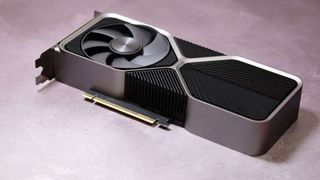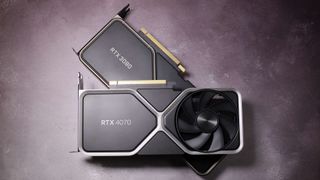Nvidia's RTX 5070 is rumoured for a CES 2025 reveal but I kinda think people need to calm down over its unconfirmed memory specs
CES 2025 is looking like it might be a hot one for GPU launches.

Rumours and unconfirmed reports regarding Nvidia's next-generation graphics cards are coming in thick and fast as we edge towards a likely launch window, but the latest scuttlebutt is causing something of a stir. The latest word is that Nvidia will be showing off its new consumer GPUs at CES 2025 in January of next year, and it won't just be the RTX 5080 and RTX 5090 getting their time in the sun.
According to Wccftech, the RTX 5070 will debut alongside its bigger sibling at next year's show. This would be something of a surprise, as traditionally Nvidia has shown off its top-end cards first, with a mid-range offering making an appearance a month (or several) later.
Wccftech also has some reported specs for the card, which make for interesting reading should they come to pass. The headline news is that it's said to feature 12 GB of VRAM (seemingly confirmed by known leaker kopite7kimi) with a 192-bit memory bus, delivering a 33% increase in memory bandwidth over the RTX 4070 and RTX 4070 Super GPUs thanks to the 28 Gbps memory speeds provided by its GDDR7 VRAM.
That's caused plenty of online grumbling, as some have speculated that this might be an attempt to push 4K gamers towards the high-end (and much more expensive) cards thanks to their higher VRAM loadouts. Several highly-demanding games already use more than 12 GB VRAM at 4K high settings, although there are several reasons why this might not be the huge deal some seem to think it is.
Nvidia has already (and with a perceptibly world-weary tone) explained why it views cache as far more important than total VRAM on the 40-series cards. This is essentially because GPUs recall data first from the L1 and L2 cache before reaching for the VRAM itself, and thereby it's been increasing L2 caches accordingly for the best performance rather than simply cramming as much VRAM as possible onto the board.
That's not to mention that some games are coded to take up as much VRAM as possible, simply because the option is there. That's not to say that VRAM size is unimportant, more that Nvidia thinks it's not a top priority for the best gaming performance.
The rest of the specs suggest a 250 W maximum power draw, which would be a 50 W increase over the RTX 4070. Seems about right that, as we've been expecting the new cards to go heavy on the power requirements compared to the previous generation. The RTX 5090, for reference, has been rumoured to have a peak rated power draw of 600 W, while the RTX 5080 has reportedly been bumped up to 400 W over the 320 W rating of the RTX 4080.
The biggest gaming news, reviews and hardware deals
Keep up to date with the most important stories and the best deals, as picked by the PC Gamer team.
As to whether Nvidia is worried about the backlash from its perceived VRAM stinginess? That seems doubtful. AMD furnished its current generation cards like the RX 7800XT with large amounts of VRAM for their market segments, and they sold poorly. That being said, the last time a big VRAM kerfuffle broke out in regards to the RTX 4060 Ti, Nvidia did backtrack somewhat by reluctantly releasing a 16 GB version. Though that in itself was seemingly more to show people that it made zero difference to gaming performance as, despite costing more, the 16 GB RTX 4060 Ti didn't make for a faster graphics card.

Best CPU for gaming: The top chips from Intel and AMD.
Best gaming motherboard: The right boards.
Best graphics card: Your perfect pixel-pusher awaits.
Best SSD for gaming: Get into the game ahead of the rest.
The other thought here, of course, is that higher VRAM models may be being held in reserve for future Super and Ti variants. That's certainly a possibility, although really what matters the most here comes down to price.
The RTX 4070 became arguably the mid-range card to buy of this generation, thanks to a more reasonable launch price point of $599 compared to the huge prices of the more powerful 40-series cards. If Nvidia can match that pricing again, my money would be on the RTX 5070 repeating the same trick, even if the VRAM specs are lesser than some were expecting.
That's reliant on a decent performance increase over the previous card for the same money, however, and time will tell on that one. CES 2025 seems an odd choice of event for an Nvidia GPU reveal, although rumours have already pointed to AMD unveiling its next-gen RDNA 4 GPUs at the same time.
Could it be that Nvidia is trying to cover off AMD? Well, given that AMD seem to be giving the high-end market a miss this generation, I doubt it, although there's always the possibility that team red has a mid-range stunner on its hands that Nvidia wants to counter with its own mid-range card. Still, if these reports turn out to be true, it looks like we might be showered in new graphics cards to talk about starting next January.

Andy built his first gaming PC at the tender age of 12, when IDE cables were a thing and high resolution wasn't. After spending over 15 years in the production industry overseeing a variety of live and recorded projects, he started writing his own PC hardware blog in the hope that people might send him things. And they did! Now working as a hardware writer for PC Gamer, Andy's been jumping around the world attending product launches and trade shows, all the while reviewing every bit of PC hardware he can get his hands on. You name it, if it's interesting hardware he'll write words about it, with opinions and everything.
Most Popular







